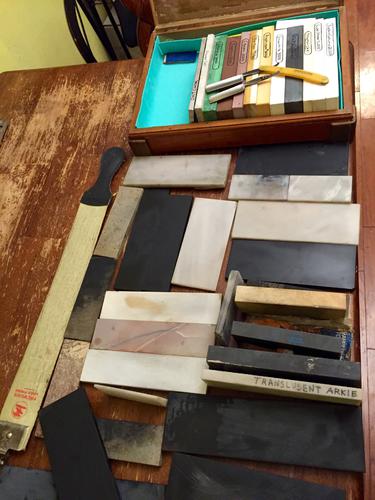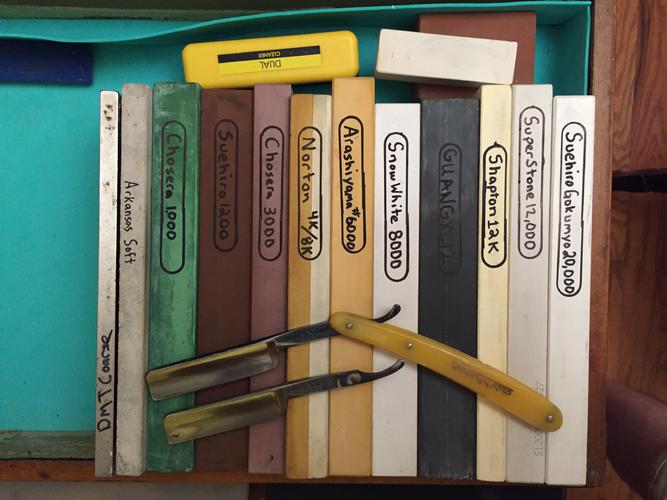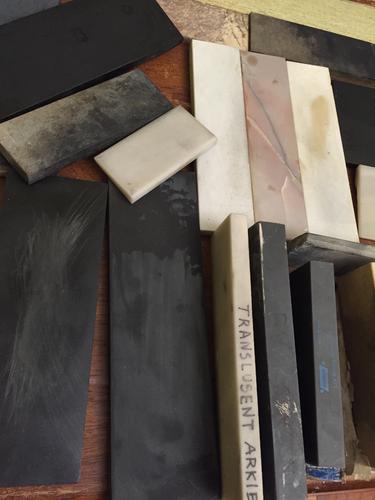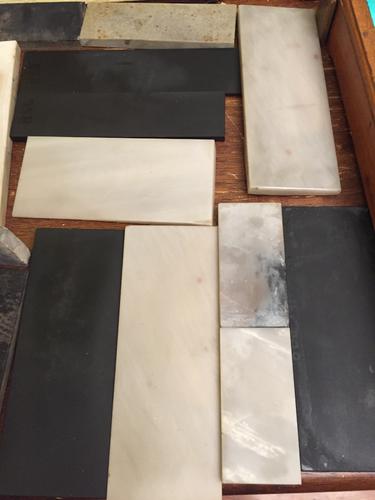Results 1 to 6 of 6
 18Likes
18Likes
Thread: Method for testing finishing stones
-
07-07-2016, 05:45 AM #1Senior Member

- Join Date
- Jul 2011
- Location
- Ponca City, Oklahoma
- Posts
- 605
Thanked: 66 Method for testing finishing stones
Method for testing finishing stones
As the title says, I am looking for recommendations on scientifically as possible testing my finishing stones, I have a few things I have been testing on my own before asking, which is use two Dubl Duck dwarfs, the two I plan to use both have a very flat edge in order to eliminate rolling x or funky strokes. The bevel is set and I have shaved on them many times.
Both of the dwarfs will be honed (as a base line) on my current standard progression finishing on 20k which I know works for me, once both dwarfs feel the same by testing one on the left face, the other on right face and I can't tell the difference, I know I have a starting point.
I have hundreds of different Arkansas stones, both SB and Translucent and variations, most are blemished stones, which is part of the problem, some might have toxic spots and/or fractures, or the spots/fractures are harmless, until I test I will never know for certain. I also have vintage Norton Surgical Black and vintage Norton Translucent, Norton lily white washita' as a baseline. There are also variations in how I lap the stones which I could write a book on, so lets just say I might test the same stone twice with different lapping techniques.
This thread is not about sharp tests, there is plenty to read up on that and it is all well documented here on SRP
So far I have a couple thoughts on how to do this. using the test Dwarf
For the Arky's
1) kill the edge on 3 no pressure strokes on a glass bottle, then go straight to the finisher with 100 strokes, then 20 linen, 20 leather
2) Kill the edge on 3 no pressure strokes on a glass bottle, then 20(??) strokes on a pre-finisher such as Norton 8k then go to the Arkansas stone. with 100, 20,20 as in #1
3) Kill the edge as above and set bevel again on Chosera 1k, then Chosera 3k, then Snow white 8k, then 100,20,20 as above.
Then perform the standards documented tests such as thumb pad, or HHT, etc. followed up by shaving one side of my face with the base line dwarf, the other side with whichever method we pick above.
I also want to test my synthetic finishers, I have Norton 8k & Original Snow white 8k, and a few other 6-8k Japanese stones I can't remember the name of. Shapton 12k & SS12, and of course a PHIG 12k and GS20k, in another box I have around 10 Thurigans and a few Coti's and other oddballl naturals. I want to test them all as finishers and shave from them, but that can be a different thread or after I get this one figured out.
So what do you think?? option 1,2 or 3, or OTHER???
Here are a few photos of what I have been working on with this test on my own, before asking for help. I still need to put a temporary handle on the other dwarf, I will get that done before I start documenting.




Last edited by sidmind; 07-07-2016 at 06:14 AM.
-
07-07-2016, 02:44 PM #2At this point in time...




- Join Date
- Jun 2007
- Location
- North Idaho Redoubt
- Posts
- 27,112
- Blog Entries
- 1
Thanked: 13249
A 7 day set it the optimum test bed

But you need at least 2 matching razors to start with IMHO, keeping in mind that the results need to be repeated with at least the major different steels
Solingen, Sheffield, American, Swedish, Japanese
And then after all that, the unfortunate reality is that the results are only for your hands on the hones, and your face under the edge
Can you tell I have done this a few times hehehe
-
07-07-2016, 09:29 PM #3Senior Member

- Join Date
- Mar 2009
- Posts
- 1,211
Thanked: 202
Can you please specify what is the goal for your test?
-
07-07-2016, 10:35 PM #4Senior Member

- Join Date
- Jul 2011
- Location
- Ponca City, Oklahoma
- Posts
- 605
Thanked: 66
Simple reason, I have lots of Arky's and many Thuri's I want to know which ones to put in my collection and which ones to ditch.
Its been part of a larger project which was to build my Synthetics collection, with the sole reason to get a baseline before testing the naturals, and of course refine my honeing technique on the synthetics before doing this testing. that and I like rocks!!! which could be reason #1 now that I think about it.Last edited by sidmind; 07-08-2016 at 01:52 AM.
-
07-08-2016, 06:34 AM #5Senior Member

- Join Date
- Mar 2009
- Posts
- 1,211
Thanked: 202
Firstly you need to adopt the same lapping preparation. For example when lapping on 400 grit plate the hone starts sticking.
As with recognition of toxicity of inclusions and fissures that shoul not be a problem. You can use 2 steel bars polished to known surface quality, such as axels for speed kniting machines. You will need to have a surplus of them as if you want to be really scientiffic you should use ne bars for each test.
One of them has to be longer than your hone the other wider than your hone. By rubbing those bars along and across right in 90 degrees to each othe with predetrmined number of strokes on the end you should be crossreference where are the inclusions as well as which one of them is toxic.
If you would be also able to make a contraption which would unify length, speed and pressure of strokes you should be able to meassure how much material was ground of therefore speed of hone.
However from what you describe you are more what will suit you and your needs and feeling therefore I would not bother with much of science and go with your feeling when you honing (feedback), sound )some can be realy quiet or screeechy) and most importantly how will be the shave from them.
As with naturals it will be impossible to unify quantity of strokes to achieve desired feeling while shaving. This is about learning your hone how to get best result for your own face.
-
07-08-2016, 01:07 PM #6

The one constant with natural stones is that there are no constants.©



 LinkBack URL
LinkBack URL About LinkBacks
About LinkBacks






 Reply With Quote
Reply With Quote
